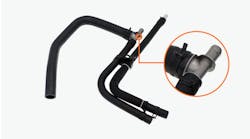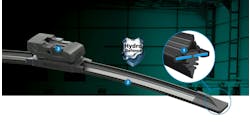There are a number of reasons to go with diesel power for pickup trucks. Key among them is engine longevity, due to its design and construction, and fuel economy. Diesels typically deliver 25 to 35 percent better fuel efficiency over gasoline engines, according to the U.S. Department of Energy. However, such advantages come with a higher cost.
Diesels are also more suited for applications that require more work – load and towing capacity – out of their pickups. That is why in the heavy duty segment, diesel take rates are high.
FUEL ECONOMY
Chrysler Group's Ram Trucks recently introduced a diesel option for its Ram 1500 pickup that, the company says, promises to deliver improved fuel economy, an important feature in the half-ton segment. “It’s interesting to see the shift,” says Mike Cairns, head of Ram Trucks engineering. “With fuel economy in the light duty segment as the driving force of change and new technology available, smaller diesel engines can deliver on both efficiency and capability.”
Brian Rathsburg, Super Duty marketing manager for Ford (www.ford.com), cautions that the fuel economy advantage can be hard to quantify due to the many different pickup configurations available. “But if you are in the F-250 (Class 2) portion of the lineup and you have a diesel and are not towing heavy loads or driving at altitude, you can get north of 20 mpg. On a similarly equipped gasoline truck, it could be in the 15- to 17-mpg range. So it is not uncommon for these customers to see 3- to 5-mpg higher fuel economy with a diesel.”
The gap widens further when you’re towing a heavy load. “Diesel engines run more efficiently at high capacities,” says Rathsburg. “On similarly equipped vehicles towing the same amounts, you will get better fuel economy on the diesel engine than you would on the gasoline engine.”
CAPACITY
However, the decision of gas or diesel is often based more on capability than fuel economy. That’s why a majority of heavy duty pickups are equipped with diesels.
Consider Ford Super Duty pickup trucks. “About 60 percent of our mix is diesel engines and the other 40 percent are gas engines,” notes the company’s Rathsburg. “For those 40 percent who buy a gas truck, they want the utility of a heavy duty truck but they may not need the extreme amount of capability that the diesel gives them. As a result, they can’t justify the $8,000 to $9,000 price premium.
“They may need to haul 3,000 or 4,000 lbs of equipment in the pickup box and not have a lot of need for towing. Those are the types of usage profiles where we see gas buyers.”
“Ram Heavy Duty trucks have nearly an 80 percent take rate on the Cummins (6.7L turbo) diesel, where the number one why buy is capability,” Ram Trucks’ Cairns says. “Our new 6.4L HEMI gas engine closes the capability gap and gives customers who may not require a huge gcwr another option.”
The power characteristics between gas and diesel are quite different. Gasoline engines run at higher rpm and typically produce more horsepower. Diesel engines turn at lower engine speeds and produce more torque.
Going from gas to diesel in a heavy duty pickup usually doubles the torque, says Tom Wilkinson with Chevrolet’s communications department. For instance, the Chevrolet Silverado and GMC Sierra use the Duramax 6.6L diesel engine that produces 397 hp at 3,000 rpm and 765 ft/lbs at 1,600 rpm. This compares to the 6.0L Vortec V8 gas engine rated at 360 hp at 5,400 rpm and 380 ft/lbs of torque at 4,200 rpm.
Such results are similar across the product offerings of all heavy duty pickup brands.
TRAILERING
Towing capacity is a complex topic because there are a lot more variables than simply the engine. There is the axle ratio, gross vehicle weight, wheel configuration, hitch configuration, etc. This is why manufacturers publish towing tables.
That said, the diesel engine does add towing capability across the range. “If you look at the range of trailering, the lowest trailer rating is 12,500 lbs for an F-250 gas regular cab,” says Ford’s Rathsburg. “That can go up to a maximum of 16,800 lbs on a diesel with fifth wheel capability. That is the full range of F-250 towing from low-end gas to high-end diesel.”
The increase in towing from gas to diesel depends on the rear axle ratio, Chevrolet’s Wilkinson points out. By way of illustration, for a basic Chevrolet Silverado 2500 2WD regular cab pickup, the ratings are:
- 6.0L gas engine with standard 4.10 axle ratio – 13,500 lbs conventional pickup model; 14,700 lbs fifth wheel version.
- 6.0L gas engine with optional 3.73 axle ratio – 10,200 lbs conventional; 10,200 lbs fifth wheel.
- 6.2L diesel engine with 3.73 axle ratio (only ratio available) – 13,000 lbs conventional; 17,800 lbs fifth wheel.
Ratings for a 2WD, dual rear wheel Chevrolet 3500 crew cab are:
- 6.0L gas engine with a 4.10 axle ratio – 13,500 lbs conventional; 13,500 lbs fifth wheel.
- 6.6L diesel engine with 3.73 axle ratio – 16,500 lbs. conventional; 22,800 lbs fifth wheel.
“At the upper end, the diesel makes much more difference,” says Wilkinson.
Ram 2500 specs show increased towing capability with the diesel when equipped with the same axle ratio. However, the increased weight of the diesel results in 830 lbs less payload capacity, as shown:
- 6.7L Cummins diesel 2-door, 2WD with 4.10 gears – 17,970 lbs towing; 3,140 lbs payload.
- 6.4L HEMI gasoline V8 2-door, 2WD with 4.10 gears – 16,300 lbs towing; 3,970 lbs payload.
For the Ram 3500 diesel, there is a significant increase in towing capacity:
- 6.7L Cummins, 2-door, 2WD, 4.10 gears – 30,010 lbs towing; 6,570 lbs payload.
- 6.4L HEMI V8, 2-door, 2WD, 4.10 gears – 16,450 lbs towing; 7,320 lbs payload.
PAYLOAD
“Payload is a function of the GVW of the truck or the maximum rating of what the truck can hold minus the weight of the truck,” says Rathsburg of Ford. “You can actually haul more with a gas truck than a diesel because the diesel weighs more. That affects your GVW.
“The payload of a similarly equipped F-250 for a diesel is 3,000 lbs and that goes up to a maximum of 4,200 lbs for a gas truck. You really see the capability benefit for a diesel truck in the trailer towing. Because the diesel truck weighs more, the payload is actually higher on a gas truck.”
The weight difference is roughly 700 lbs for an F-250 diesel over a similarly equipped gasoline model. “That is the weight of the engine, fluids, aftertreatment system, DEF tank and DEF fluid itself,” he says.
Other manufacturers note similar weight differences.
RETURN ON INVESTMENT
As noted previously, the upfront investment in a diesel engine is higher. The cost for the diesel can range anywhere from $6,000 to $8,500 or more. Therefore, the return on this investment needs to be identified up front.
The ROI will vary by customer. “Fleets and other cost-conscious customers seem to lean toward the gas engine because it is so much less expensive to purchase,” observes Wilkinson of Chevrolet. “But customers buying up-level trucks tend to favor the diesel, especially if they are doing a lot of towing. As with any premium engine, performance may be as much a factor as ROI. If you want or need torque, nothing beats a diesel.”
Ford’s Rathsburg notes that the payback period on a gas vs. diesel is difficult to quantify. “But on average, if you are driving 20,000 miles a year and are getting 3 to 5 mpg better fuel economy with a diesel, the payback will be three to five years.
“There are so many variables that it is hard to really specify it. But the general rule of thumb is the more you drive and the higher the fuel economy advantage that you see for the diesel vs. the gas engine, your payback period is going to get smaller.”
The increased capability of the diesel also plays into this equation, he adds. A Super Duty pickup can tow almost 25,000 lbs of weight; a gas-powered truck less than half of that.
The ROI isn’t always based on initial cost, points out Nick Cappa with Ram Trucks’ media group. “Towing with a bigger diesel provides confidence and comfort with fuel economy. The take rate for our 6.7L Cummins engine is around 80 percent, which says a lot about the importance of capability.
“There are varying duty cycles and some include a load weight per route calculation, of which a diesel will yield a better result. Fuel economy of a diesel under load is the greatest operational benefit when compared to a gas engine under the same load.”
RESALE VALUE
Another advantage of diesel- over gasoline-powered pickups is the resale value. There is the perception that a diesel pickup will have more remaining useful life than a gas pickup with the same amount of miles.
“We generally see about a 10 percent improvement over a gasoline engine in terms of higher resale value,” says Ram Trucks’ Cappa.
“We would expect the diesel engine to have a higher resale value because it is a more capable vehicle,” Ford’s Rathsburg adds. “It is designed to tow and haul more. We would expect to see 5 to 10 percent higher residuals for a diesel Super Duty vs. a gasoline Super Duty. That is assuming all of the other specs are the same.”




